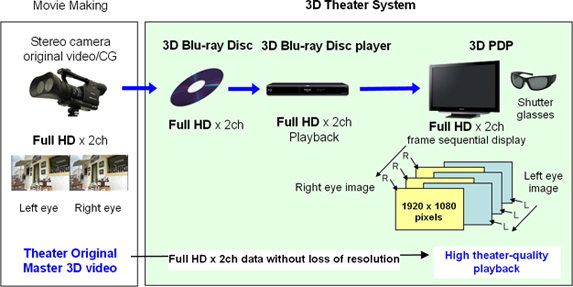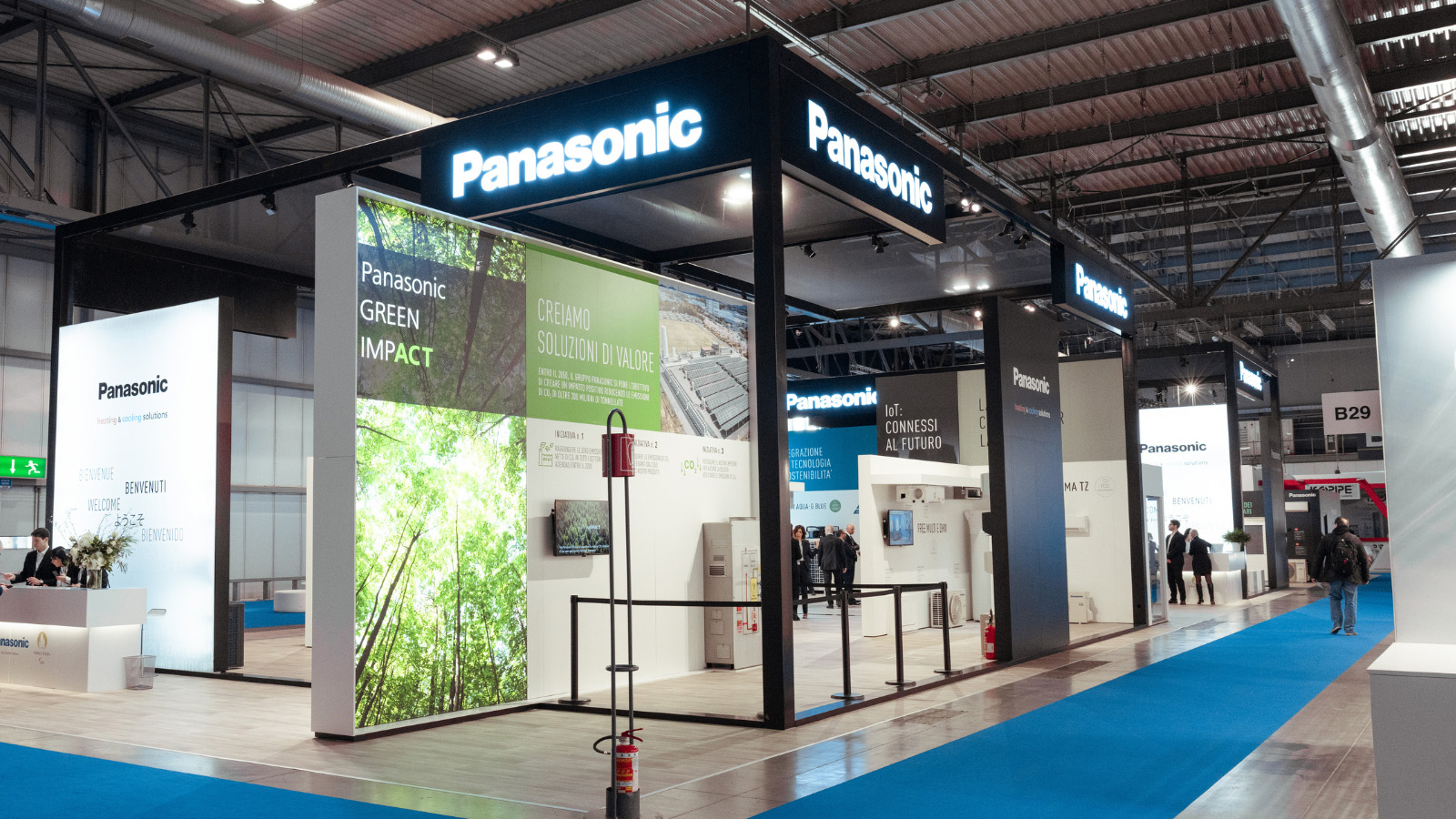Sep 28, 2009
Press Release
Panasonic Develops 50-inch Full HD 3D PDP and High-Precision Active Shutter Glasses
Osaka, Japan - Panasonic Corporation, a leader in high definition TV technology, has developed a 50-inch Full HD 3D compatible plasma display panel (PDP) and high-precision active shutter glasses that enable the viewing of theater-quality, true-to-life 3D images in the living rooms. Aiming to bring Full HD 3D TVs to the market in 2010, the company steps up its efforts in developing the related technology. Prototype Full HD 3D TV and glasses will be displayed at CEATEC JAPAN 2009 to be held from October 6 to 10 at Makuhari Messe in Chiba City, east of Tokyo.
The new PDP and glasses evolved from Panasonic's world-first Full HD 3D Plasma Home Theater System1 that was developed in 2008 and comprised of a 103-inch PDP and a Blu-ray Disc player. The prototype PDP has a 50-inch screen, which is expected to become the most popular size for home theaters.
This 50-inch PDP uses Panasonic's newly-developed high-speed 3D drive technology that enables rapid illumination of pixels while maintaining brightness. The panel also incorporates a crosstalk reduction technology allowing for minimizing double-image (ghosting) that occurs when left- and right-eye images are alternately displayed. PDPs have excellent video response with full moving picture resolution2. The new panel offers even improved performance, achieving clear, high-quality and high-resolution images in 3D. The high-precision active shutter glasses incorporate Panasonic's technology that precisely controls the active shutters with the left- and right-eye images shown on the PDP.
All these technologies work in tandem with each other to create Full HD 3D images that deliver an immersive, movie-theater-like experience in which the viewers can feel as if they were part of the scene. They represent Panasonic's concept of 3D products: "Bringing the movie theater experience into the living rooms."
Panasonic has been working to develop its original Full HD 3D technology3 to create synergy between PDPs, which excel in moving picture resolution and color reproduction, and Blu-ray Disc players, which are able to faithfully reproduce high quality Hollywood 3D movies. Panasonic continues to work on developing 3D products to allow its customers to enjoy the immersive 3D world in their living rooms, targeting to launch the products in Japan, Europe, and the U.S. in 2010. (Subject to approval of the 3D Expanded Standard4.)
To describe further about the technologies involved with the new panel, Panasonic newly developed the high-speed 3D drive and crosstalk reduction technologies to improve plasma's unique properties to deliver crisp and clear Full HD 3D images. As PDPs are self-illuminating device with full motion-picture resolution, they offer fast response time and are suitable to display fast-moving images. The high-speed 3D drive technology involves the development of new panel materials and LSIs that accelerate the pixel illumination while maintaining brightness. Panasonic also developed the crosstalk reduction technology using newly-developed phosphors with short luminescence decay time and illumination control technology to reduce double-images that occur when left- and right-eye image are alternated on the panel. This technology contributes to achieving high-quality clear pictures with high-contrast and accurate color reproduction. As the new technologies can also be applied to improve the quality of 2D images, they have expanded PDP's potentials for further evolution.
To reproduce 3D images, Panasonic uses the Full HD x 2 frame5 sequential method that displays time sequential images, alternately reproducing discrete 1920 x 1080 pixel images for the left and right eyes on the display frame by frame. The frame sequential method is widely used in showing Hollywood 3D movies in theaters. The new panel elevates home entertainment to a whole new level with theater-quality 3D images.
The high-precision active shutter glasses employ Panasonic's technology that precisely controls the timing of opening and closing the shutter in synchronization with the left- and right-eye images alternately shown on the PDP. This technology enables significant reduction of crosstalk that degrades the image resolution in 3D display. The glasses are designed to fit for a wide range of users from children to the elderly.
Notes:
1) World's first system to create high quality, true-to-life 3D images by distributing full HD images to the left eye and right eye.
2) Moving picture resolution indicates the motion display performance by number of lines which human eyes can recognize. (Measured by Advanced PDP Development Center Corporation Method). Full moving picture resolution has 1080 lines.
3) Full HD x 2 frame sequential method displays time sequential images, alternately reproducing discrete 1920 x 1080 pixel images for the left and right eyes on the screen frame by frame. In combination with the full HD PDP, the method reproduces high-quality, true-to-life full HD 3D images.
4) The 3D Expanded Standard is currently under review by the Blu-ray Disc Association (BDA).
5) A unit of pictures in a video signal. In digital high-definition broadcasts in Japan, 30 frames are transmitted per second.
<Reference>
Panasonic Full HD 3D World
Features of Panasonic's Full HD 3D System
Panasonic's full HD 3D system uses the full HD x 2 frame sequential method and takes full advantage of the unique properties of the most advanced PDP device such as high-speed illumination and color reproduction to create immersive, true-to-life and high-quality full HD 3D images.
The 3D experience occurs because the left and right eyes recognize different images. In September last year, Panasonic developed the Full HD 3D Plasma Home Theater System, comprised of Blu-ray Discs onto which 3D video consisting of left- and right-sided 1080p full HD images is recorded, a Blu-ray Disc player to play them back, and a PDP display to show them.
Full HD (1920 x 1080 pixels) image processing occurs on both the left- and right-sided 3D images in every single process - from recording, playback and display. With a special pair of glasses, the viewer is able to experience 3D images formed with twice the volume of information as regular full HD images, and enjoy them together with high-quality surround sound.

The Development Process
With the recent rise in digital cinema, the number of movie theaters playing 3D movies has increased and Hollywood film studios are actively making 3D movies. The shift in packaged software from DVDs to Blu-ray Discs is also accelerating.
At the same time, as the flat-panel TV market expands globally, video display technology has been evolving at an accelerated pace in pursuit of higher picture quality and higher performance.
Against such a background, Panasonic is accelerating its development of 3D-compatible audiovisual equipment, such as large screen PDPs to implement its 3D product concepts: "Bringing emotional experience of a movie theater into the living rooms," and "Creating immersive experience as if you were right there." The company is also stepping up its efforts towards the spread of its technologies.
Panasonic aims to deliver a 3D world into the home by capitalizing on its comprehensive expertise in 3D from production systems for movie studios to display panels for homes. The company is strengthening its efforts to spread its 3D technology.
Development of 3D-compatible Audiovisual Equipment at Panasonic
- September 2008: Development of Full HD 3D Plasma Home Theater System
Developed the world's first Full HD 3D Plasma Home Theater System based on a 103-inch PDP and Blu-ray Discs, which was exhibited at CEATEC JAPAN 2008. - April 2009: Began development of Professional 3D Movie Production System
Became the first company in the industry to announce the start of development of professional 3D production system consisting of a twin-lens P2 camcorder, a 3D video recorder and a PDP that allows for evaluation of 3D video. The system will facilitate easier and more efficient 3D production process. The conceptual models were presented at NAB 2009. - September 2009: Development of 50-inch Full HD 3D PDP
Developed a 50-inch Full HD 3D compatible PDP to enable consumers to enjoy high quality, true-to-life 3D images in the comfort of their living rooms. A prototype will be exhibited at CEATEC JAPAN 2009 (from October 6-10).
Approaches towards the Spread of 3D Technology
- February 2009: Establishment of the Authoring Center
Announced the establishment of the Panasonic Hollywood Laboratory Advanced Authoring Center to support Hollywood studios in developing 3D Blu-ray Disc titles. - August 2009: Agreement on cooperation in making Twentieth Century Fox's new movie AVATAR and joint promotion.
Announced an agreement with Twentieth Century Fox and the movie production company Lightstorm Entertainment to cooperate in the making of the new movie AVATAR and joint promotion.
Future Approaches
To bring high-quality, realistic full HD 3D images to homes, Panasonic is planning to bring 3D products to the market by further advancing its proprietary full HD 3D system technology and PDP device's superb video display capabilities.
The company will also strengthen its cooperation with Hollywood movie studios and consumer electronics manufacturers in the Blu-ray Disc Association (BDA) and work together to spread 3D systems. Through these efforts, the company will contribute to the creation of a new, exciting viewing experience.
About Panasonic
Panasonic Corporation is a worldwide leader in the development and manufacture of electronic products for a wide range of consumer, business, and industrial needs. Based in Osaka, Japan, the company recorded consolidated net sales of 7.77 trillion yen (US$78.4 billion) for the year ended March 31, 2009. The company's shares are listed on the Tokyo, Osaka, Nagoya and New York (NYSE: PC) stock exchanges. For more information on the company and the Panasonic brand, visit the company's website at http://panasonic.net.
Media Contacts:
- Akira Kadota, International PR
- Panasonic Corporation
- Tel: 03-6403-3040 Fax: 03-3436-6766
- Panasonic News Bureau
- Tel: 03-3542-6205 Fax: 03-3542-9018
Banner area begins from here.
The content in this website is accurate at the time of publication but may be subject to change without notice.
Please note therefore that these documents may not always contain the most up-to-date information.
Please note that German, French and Chinese versions are machine translations, so the quality and accuracy may vary.






